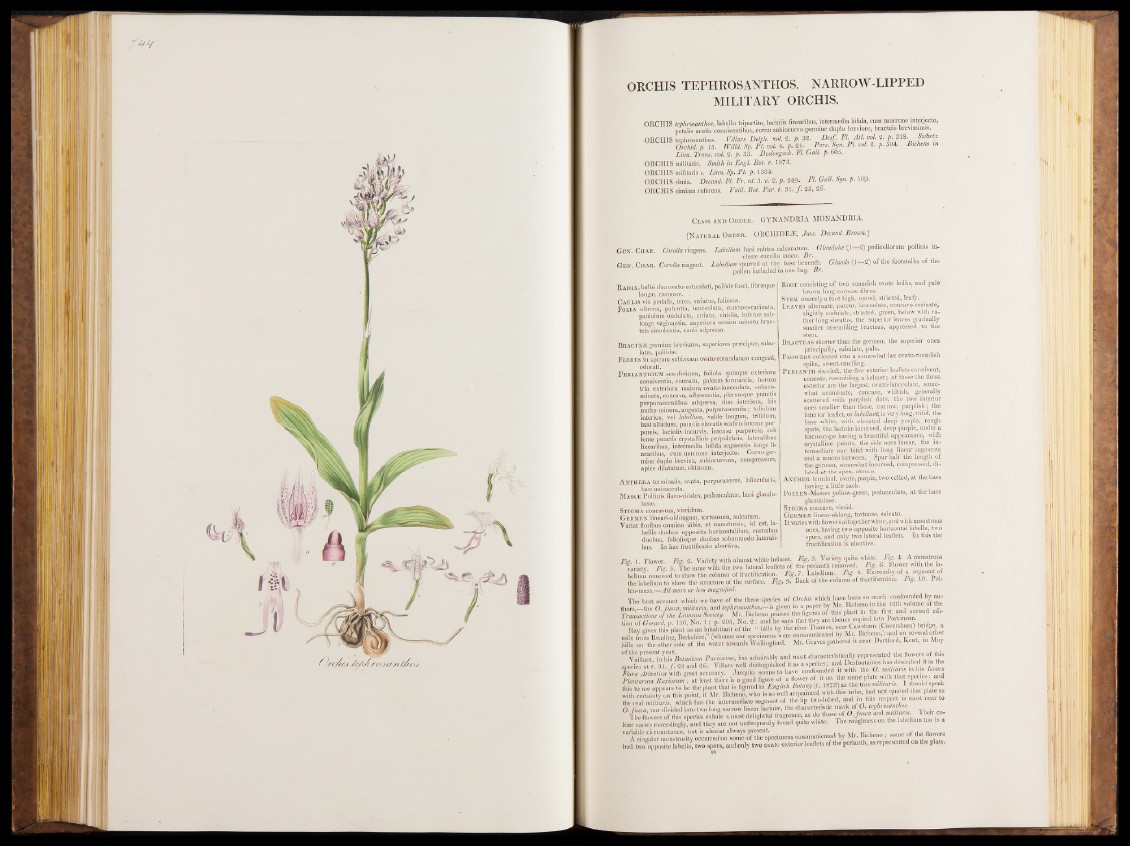
ORCHIS TEPHROSANTHOS. NARROW-LIPPED
MILITARY ORCHIS.
ORCHIS tephrosanthos, labello tripartito, laciniis linearibus, intermedia bifida, cum mucrone interjecto,
petalis acutis conniventibus, cornu subincurvo germine duplo breviore, bracteis brevissimis.
ORCHIS tephrosanthos. Villars Delph. ml. 2. p. 32. Desß Fl. A tl.m l. 2.
Orchid. p. 15. TVilld. Sp. PI. ml. 4. p. 21. Pers. Syn. PI. ml. 2. p. 504, Bicheno ;n
L im . Trans, ml. ä. p. 33. Deslongsch. Fl. Gail. p. 605.
ORCHIS militaris. Smith in Engl. Bot. t. 1873,
ORCHIS militaris ,. Zinn. Sp. PI. p. 1334.
ORCHIS simia. Decand. Fl. Fr. ed. 3. v. 2. p. 249- . Fl. Gail. Syn. p. 169,
ORCHIS simiam roferens. Vaill. Bot. Par. t. 31. ƒ . 25, 26. .
Class and Oedee. GYNANDRIA MONANDRIA,
[N a toeal Oe d e e , ORCHIDE2E, Juso. Decani. Brown.]
Ge n . Ch ar, Corolla ringens. Labdlum basi subtils calcaratum. Glandula (1—2) pedicellorum pollinis in-
clusæ cucullo uhico. B r .
Ge n . Ch a r . Corolla ringent. Labdlum spurred at th<
pollen included
R adix, bulbi duo ovato-rotundati, pallide fusci, fibneque
longæ, carnosoe.. •
Caulis vix pedalis, teres, striatus, foliosus.
F olia alterna, patentia, lanceolata, concavo-carjnata,
paululum undulata, striata, viridia, inferne sub-
• ■ longe vaginantia, superiora sensitn minora bracteis
simulantia, cauli ad pressa.
T3racte2e germine breviores, superiores præcipue, subu-
latæ, pallidæ.
F lores in spicam sublaxam ovato-rotundatam congesti,
odorati. .
P e r ia n THIUM sex-divisum, foliola quinque exteriora
conniventia, connata, galeam formantia, horum
tria exteriora majora ovato-lanceolata, subacu-
minata, concava, albescentia, plerumque punctis
purpurascentibus adspersa, duo interiora, his
multo minora, angusta, purpurascentia ; foliolum
interius, vcl labdlum, valde longum, trifidum,
basi albidum, punctis elevatis scabris intense pur-
pureis, laciniis inpurvis, intense purpureis, sub
lente punctis drystallinis perpulchris, lateralibus
linearibus, intermedia bifida segmentis longe linearibus,
cum mucrone interjecto. Cornu ger-
■ mine duplo brevius, subincurvum, compressum,
apice dilatatum, obtusüm.
Anth era terminalis, ovata, purpurascens, bilocularis,
basi unisaccata.
Massæ, Pollinis flavo-virides, pedunculatæ, basi glandu-
Stigma concavum, viscid uni,
G e rmen lineari-oblongum, tortuosura, sulcatum.
Variât floribus omnino albis, et monstrosis; id est, labellis
duobus oppositie horizontalibus, cornubus
duobus, foliolisque duobus solummodo lateralibus.
In hac fructificatio abortiva.
5 base beneath. Glands (1—2) of the footstalks of the
in one bag. B r .
Root consisting of two roundish ovate bulbs, and paid
brown long carnose fibres.
Stem scarcely a foot high, round, striated, leafy.
L eaves alternate, patent, lanceolate, concavo-carinate,
slightly undulate,-striated, green, below with rather
long sheaths, the superior leaves gradually
smaller resembling bracteas, appressed to the
stem.
Bracteas shorter than the germen, the superior ones
. principally, subulate, pale.
F lowers collected into a somewhat lax ovato-roundish
spike, sweet-smelling.
P e r ia n t h six-cleft, the five exterior leaflets connivent,
connate, resembling a helmet; of these the three
exterior are the largest, ovato-lanceolate, somewhat
acuminate, concave, whitish, generally
scattered with purplish dots, the two interior
ones smaller than these, narrow, purplish; the
interior leaflet, or labellunf, is very long, trifid, the
base white, with elevated deep purple, rough
spots, the lacinue incurved, deep purple, under a
microscope having a. beautiful appearance, with
crystalline points, the side ones linear, the intermediate
one bifid with long linear segments
and a mucro between. Spur half the length of
the germen, somewhat incurved, compressed, dilated
a t the apex, obtuse.
ANTHER terminal, ovate, purple, two-celled, at the base
having a little sack. _
PoLLEN-Masses yellow-green, pedunculate, at the base
glandulose.
St igma concave, viscid.
Ge rmen linear-oblong, tortuose, sulcate.
I t varies with flowers altogether white, and with monstrous
ones, having two opposite horizontal labella, two
spurs, and only two lateral leaflets, In this the
fructification is abortive.
fUr i Flower. Fig. 2. Variety with almost white helmet. Fig. 3. Variety quite while. Fig. 4. A monstrous
1 variety. Fir. 5. The same with the two lateral leaflets of the perianth removed. E g . 6. Flower with the la.
bellum removed to show the column of fructification. -^£•.7. Labellum. ig- ■ ^ 0 A V ^ o ^ P o l
the labellum to show the structure of the surface. Fig. 9. Back of the column of tru n c a tio n . Fig. 10, Pollen
mass.— A ll more or less magnified.
The best account which we have of the three species of Orchis which have beeri so much cc,nfo,mded. b j-auth
o rs ,-th e O. fusca, militaris. and tephrosanthos - i s gi ven in a paper by Mr, jM a B l B I M S i l i i i
Transactions o f the Li,mean Society. Mr. Bicheno praises the figures of this plant in_ the first: andsecond
tion of Gerard n. 156', No. 1 ; p. 205, No. 2 : and he says that they are thence copied into ia ik nson
Ray aives this pliint as an inhabitant of the “ hills by the river Thames, near Cawsham (Caversham) bridge, a
milc7otn Reading, Berkshire," (whence our specimens Jvere communicated by BM i M M l S S M
hills on the other side of the water towards Wallingford. Mr. Graves gathered it near Dartfoid, Rent, in May
0f V a i C ^ i S s ' Botanicon Parisieme, has admirably and most characteristically represented the flowers of this 311«
O fusca not divided into two long narrow linear lacmiffi, the characteristic maik of 0 . tephiosanthos,
The flowers of this species exhale a most delightful fragrance, as do those of O. fusca
lour varies exceedingly, and they are not upfrequently found quits white. The roughness on the labellum too is a
variable circumstance, but is almost always present. • , a A singular monstrosity occurred on some of the specimens communicated by MMrr. RBiipchhpennno •, «sonminee ootf tthnee fnloowweerrss
bad twoopposite labella! two spurs, and only two ovate exterior leaflets of the perianth, as represented on the plate,